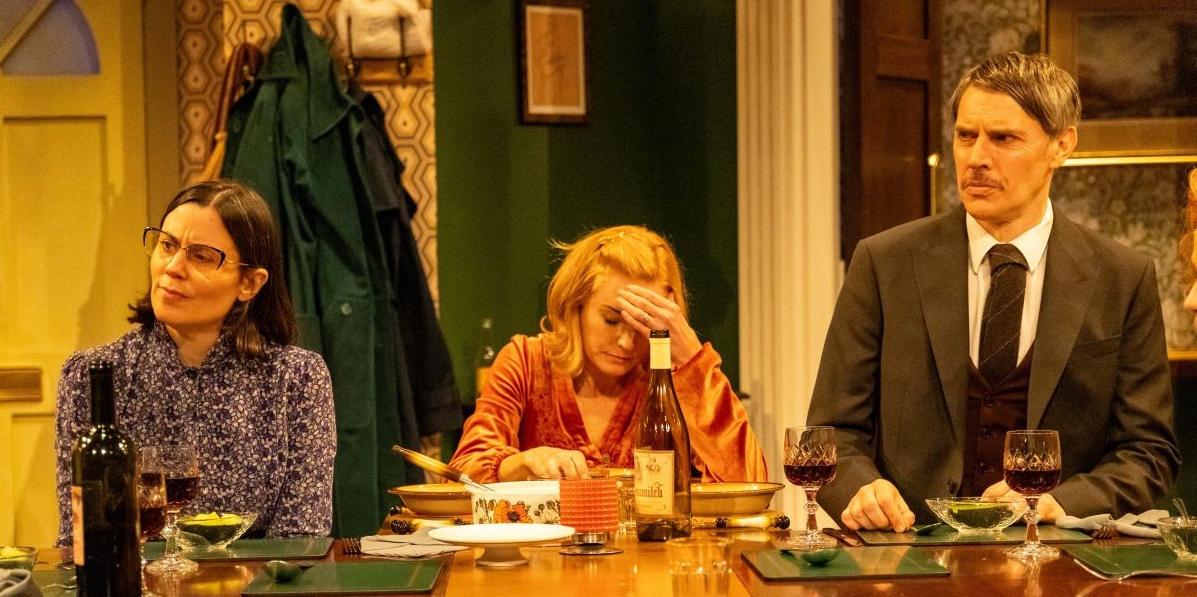Back at the Mill at Sonning on a languorous, late-summer afternoon it is time for Ayckbourn, and ‘How The Other Half Loves’ in particular. This is one of his very earliest successes, dating from 1970. Just like Sondheim’s ‘Company’ from the same year it is focused on the conundrums of couples, in this case middle-class English ones, caught up in the coiled conventions of dinner parties and multiple levels of deceit. So far, so familiar. But this is also one of the first of his plays in which we see him playing fast and loose with time and place. We see events involving three couples play out across a set that contains elements of two homes, with characters crossing the stage oblivious of each other and in one classic scene two dinner parties on successive nights merge in one ever-more fantastical skein of dialogue.
As ever, Ayckbourn is a master of planting information, catch phrases, and plot themes at apparent random that only come to glorious fruition much later in the play in a culminating dovetailing as meticulous as origami. This is still a gloriously funny play. But in other respects what was bang up-to-date in 1970 is inevitably dated now, particularly misunderstandings and missed connections on landline telephones that seem positively antique in a world of mobile devices. There is not much that can be done about this without major revisions to the text, other than ensuring that the delivery is incisive and pacy, and playing up to the full the elements of visual farce that are already there, especially in the second act. While the cast was universally solid in this production, my own sense was that at times the pace flagged as the director placed a bit too much emphasis on development of character at the expense of action. Playing with the edge of darkness and even unkindness that hovers on the edge of this dramatist’s work is certainly one way to direct things; but I was not entirely convinced that veteran Ayckbourn director, Robin Herford, made the right choice in this case.
Having said that the cast did a great job overall. The three couples are all linked by the fact that the men work in the same firm, so issues of class and hierarchy come into focus here as much as gender politics. Frank and Fiona are the oldest couple, stuck in a long stale marriage with little personal communication. Stuart Fox is excellent in conveying Frank’s eccentricities and vague grip on human realities, and Julia Hills captures Fiona’s frustrations and pretensions in equal measure. We quite understand why she is bored enough to embark on an affair with Bob Phillips, the ‘Office Romeo’. He and his wife Teresa have a robustly dysfunctional marriage from the start and much of the energy of the first half comes from the uninhibited gusto with which Damien Matthews and Ruth Gibson lay into one another. As usual in Ayckbourn there is a socially awkward, put-upon couple who often fall victim to the wiles of their more socially sophisticated neighbours. Filling these roles are Emily Pithon and Ben Porter as the gauche William and Mary Featherstones, dupes of the main deceptions and misunderstandings of the evening. I was particularly taken by the physical acting of Ben Porter whose inarticulacy became paradoxically eloquent and whose desperation to make an excuse to find a toilet was a virtuoso display of silent agony.
All credit to the set designer Michael Holt for laying out Ayckbourn’s intentions so lucidly. Despite considerable scope for confusion we are never in any doubt what is going on and why. Also Natalie Titchener has done a great job with the costumes in capturing 1970s fashions in all their unfiltered, ghastly glory. Telling touches such as contemporary copies of the Radio Times and a brick of a telephone directory show a keen eye for period detail. Scene changes do take a while, but I see now way around that other than introducing a further interval which would destroy continuity.
Taken in combination with the ambience and the well-known, lavish, pre-theatre catering, this play offers a delightful day or evening out well worth the time of Londoners as much as locals.

